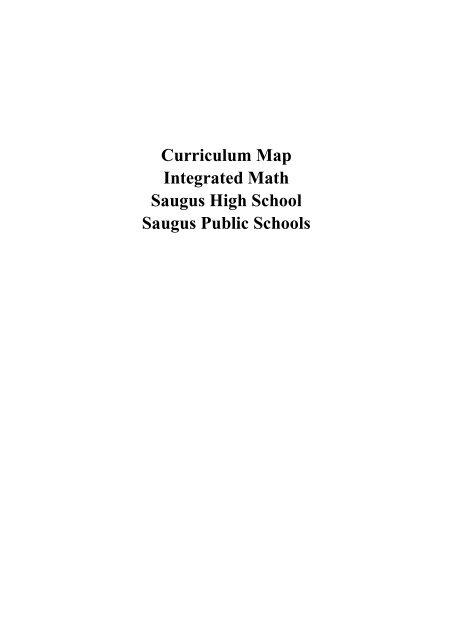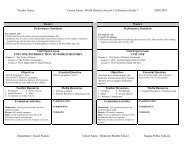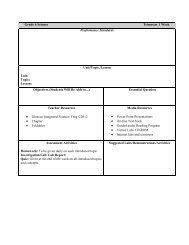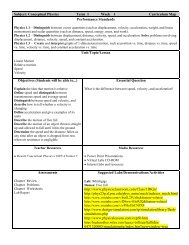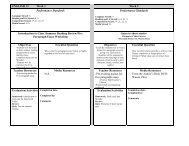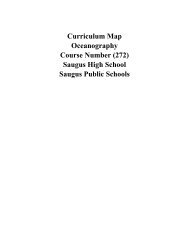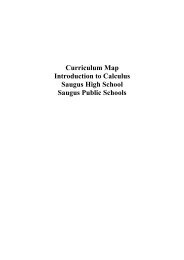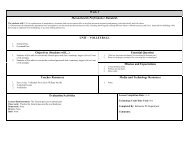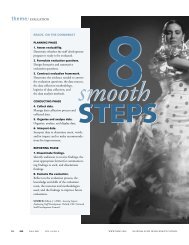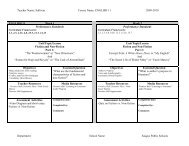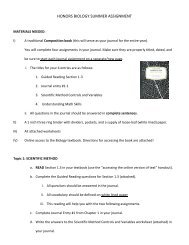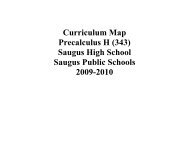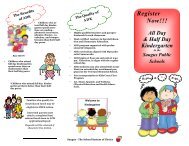Integrated Math Curriculum Map CCSS - Saugus Public Schools
Integrated Math Curriculum Map CCSS - Saugus Public Schools
Integrated Math Curriculum Map CCSS - Saugus Public Schools
Create successful ePaper yourself
Turn your PDF publications into a flip-book with our unique Google optimized e-Paper software.
<strong>Curriculum</strong> <strong>Map</strong><br />
<strong>Integrated</strong> <strong>Math</strong><br />
<strong>Saugus</strong> High School<br />
<strong>Saugus</strong> <strong>Public</strong> <strong>Schools</strong>
The Standards for <strong>Math</strong>ematical Practice<br />
The Standards for <strong>Math</strong>ematical Practice describe varieties of expertise that mathematics educators at all levels should seek to develop<br />
in their students. These practices rest on the following two sets of important “processes and proficiencies,” each of which has<br />
longstanding importance in mathematics education:<br />
• The NCTM process standards<br />
o problem solving<br />
o reasoning and proof<br />
o communication<br />
o representation<br />
o connections<br />
• The strands of mathematical proficiency specified in the National Research Council’s report “Adding It Up”<br />
o adaptive reasoning<br />
o strategic competence<br />
o conceptual understanding (comprehension of mathematical concepts, operations, and relations)<br />
o procedural fluency (skill in carrying out procedures flexibly, accurately, efficiently, and appropriately)<br />
o productive disposition (habitual inclination to see mathematics as sensible, useful, and worthwhile, coupled<br />
with a belief in diligence and one’s own efficacy)<br />
1. Make sense of problems and persevere in solving them.<br />
<strong>Math</strong>ematically proficient students start by explaining to themselves the meaning of a problem and looking for entry points to its<br />
solution. They analyze givens, constraints, relationships, and goals. They make conjectures about the form and meaning of the<br />
solution and plan a solution pathway rather than simply jumping into a solution attempt. They consider analogous problems, and<br />
try special cases and simpler forms of the original problem in order to gain insight into its solution. They monitor and evaluate<br />
their progress and change course if necessary. Older students might, depending on the context of the problem, transform algebraic<br />
expressions or change the viewing window on their graphing calculator to get the information they need. <strong>Math</strong>ematically<br />
proficient students can explain correspondences between equations, verbal descriptions, tables, and graphs or draw diagrams of<br />
important features and relationships, graph data, and search for regularity or trends. Younger students might rely on using<br />
concrete objects or pictures to help conceptualize and solve a problem. <strong>Math</strong>ematically proficient students check their answers to<br />
problems using a different method, and they continually ask themselves, “Does this make sense?” They can understand the<br />
approaches of others to solving complex problems and identify correspondences between different approaches.<br />
2. Reason abstractly and quantitatively.<br />
<strong>Math</strong>ematically proficient students make sense of the quantities and their relationships in problem situations. Students bring two<br />
complementary abilities to bear on problems involving quantitative relationships: the ability to decontextualize—to abstract a<br />
given situation and represent it symbolically, and manipulate the representing symbols as if they have a life of their own, without<br />
necessarily attending to their referents—and the ability to contextualize, to pause as needed during the manipulation process in<br />
order to probe into the referents for the symbols involved. Quantitative reasoning entails habits of creating a coherent<br />
representation of the problem at hand; considering the units involved; attending to the meanings of quantities, not just how to<br />
compute them; and knowing and flexibly using different properties of operations and objects.<br />
3. Construct viable arguments and critique the reasoning of others.<br />
<strong>Math</strong>ematically proficient students understand and use stated assumptions, definitions, and previously established results in<br />
constructing arguments. They make conjectures and build a logical progression of statements to explore the truth of their<br />
conjectures. They are able to analyze situations by breaking them into cases, and can recognize and use counterexamples. They<br />
justify their conclusions, communicate them to others, and respond to the arguments of others. They reason inductively about<br />
data, making plausible arguments that take into account the context from which the data arose. <strong>Math</strong>ematically proficient students<br />
are also able to compare the effectiveness of two plausible arguments, distinguish correct logic or reasoning from that which is<br />
flawed, and—if there is a flaw in an argument—explain what it is. Elementary students can construct arguments using concrete<br />
referents such as objects, drawings, diagrams, and actions. Such arguments can make sense and be correct, even though they are<br />
not generalized or made formal until later grades. Later, students learn to determine domains to which an argument applies.<br />
Students at all grades can listen or read the arguments of others, decide whether they make sense, and ask useful questions to<br />
clarify or improve the arguments.
4. Model with mathematics.<br />
<strong>Math</strong>ematically proficient students can apply the mathematics they know to solve problems arising in everyday life, society, and<br />
the workplace. In early grades, this might be as simple as writing an addition equation to describe a situation. In middle grades, a<br />
student might apply proportional reasoning to plan a school event or analyze a problem in the community. By high school, a<br />
student might use geometry to solve a design problem or use a function to describe how one quantity of interest depends on<br />
another. <strong>Math</strong>ematically proficient students who can apply what they know are comfortable making assumptions and<br />
approximations to simplify a complicated situation, realizing that these may need revision later. They are able to identify<br />
important quantities in a practical situation and map their relationships using such tools as diagrams, two-way tables, graphs,<br />
flowcharts and formulas. They can analyze those relationships mathematically to draw conclusions. They routinely interpret their<br />
mathematical results in the context of the situation and reflect on whether the results make sense, possibly improving the model if<br />
it has not served its purpose.<br />
5. Use appropriate tools strategically.<br />
<strong>Math</strong>ematically proficient students consider the available tools when solving a mathematical problem. These tools might include<br />
pencil and paper, concrete models, a ruler, a protractor, a calculator, a spreadsheet, a computer algebra system, a statistical<br />
package, or dynamic geometry software. Proficient students are sufficiently familiar with tools appropriate for their grade or<br />
course to make sound decisions about when each of these tools might be helpful, recognizing both the insight to be gained and<br />
their limitations. For example, mathematically proficient high school students analyze graphs of functions and solutions generated<br />
using a graphing calculator. They detect possible errors by strategically using estimation and other mathematical knowledge.<br />
When making mathematical models, they know that technology can enable them to visualize the results of varying assumptions,<br />
explore consequences, and compare predictions with data. <strong>Math</strong>ematically proficient students at various grade levels are able to<br />
identify relevant external mathematical resources, such as digital content located on a website, and use them to pose or solve<br />
problems. They are able to use technological tools to explore and deepen their understanding of concepts.<br />
6. Attend to precision.<br />
<strong>Math</strong>ematically proficient students try to communicate precisely to others. They try to use clear definitions in discussion with<br />
others and in their own reasoning. They state the meaning of the symbols they choose, including using the equal sign consistently<br />
and appropriately. They are careful about specifying units of measure, and labeling axes to clarify the correspondence with<br />
quantities in a problem. They calculate accurately and efficiently, express numerical answers with a degree of precision<br />
appropriate for the problem context. In the elementary grades, students give carefully formulated explanations to each other. By<br />
the time they reach high school they have learned to examine claims and make explicit use of definitions.<br />
7. Look for and make use of structure.<br />
<strong>Math</strong>ematically proficient students look closely to discern a pattern or structure. Young students, for example, might notice that<br />
three and seven more is the same amount as seven and three more, or they may sort a collection of shapes according to how many<br />
sides the shapes have. Later, students will see 7 × 8 equals the well-remembered 7 × 5 + 7 × 3, in preparation for learning about<br />
the distributive property. In the expression x 2 + 9x + 14, older students can see the 14 as 2 × 7 and the 9 as 2 + 7. They recognize<br />
the significance of an existing line in a geometric figure and can use the strategy of drawing an auxiliary line for solving<br />
problems. They also can step back for an overview and shift perspective. They can see complicated things, such as some algebraic<br />
expressions, as single objects or as being composed of several objects. For example, they can see 5 – 3(x – y) 2 as 5 minus a<br />
positive number times a square, and use that to realize that its value cannot be more than 5 for any real numbers x and y.<br />
8. Look for and express regularity in repeated reasoning.<br />
<strong>Math</strong>ematically proficient students notice if calculations are repeated, and look both for general methods and for shortcuts. Upper<br />
elementary students might notice when dividing 25 by 11 that they are repeating the same calculations over and over again, and<br />
conclude they have a repeating decimal. By paying attention to the calculation of slope as they repeatedly check whether points<br />
are on the line through (1, 2) with slope 3, middle school students might abstract the equation (y – 2)/(x – 1) = 3. Noticing the<br />
regularity in the way terms cancel when expanding (x – 1)(x + 1), (x – 1)(x 2 + x + 1), and (x – 1)(x 3 + x 2 + x + 1) might lead them<br />
to the general formula for the sum of a geometric series. As they work to solve a problem, mathematically proficient students<br />
maintain oversight of the process, while attending to the details. They continually evaluate the reasonableness of their<br />
intermediate results.
Connecting the Standards for <strong>Math</strong>ematical Practice to the Standards for <strong>Math</strong>ematical<br />
Content<br />
The Standards for <strong>Math</strong>ematical Practice describe ways in which developing student practitioners of the discipline of mathematics<br />
increasingly ought to engage with the subject matter as they grow in mathematical maturity and expertise throughout the elementary,<br />
middle, and high school years. Designers of curricula, assessments, and professional development should all attend to the need to<br />
connect the mathematical practices to mathematical content in mathematics instruction.<br />
The Standards for <strong>Math</strong>ematical Content are a balanced combination of procedure and understanding. Expectations that begin with the<br />
word “understand” are often especially good opportunities to connect the practices to the content. Students who lack understanding of<br />
a topic may rely on procedures too heavily. Without a flexible base from which to work, they may be less likely to consider analogous<br />
problems, represent problems coherently, justify conclusions, apply the mathematics to practical situations, use technology mindfully<br />
to work with the mathematics, explain the mathematics accurately to other students, step back for an overview, or deviate from a<br />
known procedure to find a shortcut. In short, a lack of understanding effectively prevents a student from engaging in the mathematical<br />
practices.<br />
In this respect, those content standards which set an expectation of understanding are potential “points of intersection” between the<br />
Standards for <strong>Math</strong>ematical Content and the Standards for <strong>Math</strong>ematical Practice. These points of intersection are intended to be<br />
weighted toward central and generative concepts in the school mathematics curriculum that most merit the time, resources, innovative<br />
energies, and focus necessary to qualitatively improve the curriculum, instruction, assessment, professional development, and student<br />
achievement in mathematics.
<strong>Integrated</strong> <strong>Math</strong> ( 341) Term One Week 1<br />
Common Core State Standards<br />
The students will:<br />
F.IF.1 Understand that a function from one set (called the domain) to another set (called the range) assigns<br />
to each element of the domain exactly one element of the range. If f is a function and x is an element of its<br />
domain, then f(x) denotes the output of f corresponding to the input x. The graph of f is the graph of the<br />
equation y = f(x).<br />
F.IF.4 For a function that models a relationship between two quantities, interpret key features of graphs<br />
and tables in terms of the quantities, and sketch graphs showing key features given a verbal description of the<br />
relationship. Key features include: intercepts; intervals where the function is increasing, decreasing, positive,<br />
or negative; relative maximums and minimums; symmetries; end behavior; and periodicity.<br />
Unit One<br />
Models of Variation and Growth<br />
• Functions and Graphs (F.IF.1)<br />
• Linear Models and Direct Variation (F.IF.4)<br />
Objectives<br />
The students will be able to…<br />
• describe the graphs of functions.<br />
Essential Question<br />
What is direct and inverse variation?<br />
• write equations of lines in slope intercept form.<br />
• find the slope of a line.<br />
Teacher Resources<br />
McDougal Littell © 2002<br />
<strong>Integrated</strong> <strong>Math</strong> 2<br />
• Chapter Two lessons<br />
• Chapter Two Practice Worksheets<br />
• Chapter Two Pre-Made Assessments<br />
• Chapter Two Enrichment Activities<br />
• Chapter Two Study Guide<br />
Assessments<br />
Homework: To be given daily on each introduced<br />
topic.<br />
Class Discussion: Students will be expected to be<br />
prepared for class, participate in class activities and<br />
actively engage in class discussion.<br />
Quiz: On concepts involving Functions and Graphs<br />
Baseline Assessment: The Baseline Assessment<br />
focused on Intermediate Algebraic and Geometric<br />
Concepts will be given the 1 st week of classes.<br />
Media and Technology Resources<br />
McDougal Littell © 2002<br />
<strong>Integrated</strong> <strong>Math</strong> 2<br />
• Test ExamPro Generator<br />
• Kuta software<br />
• Smart exchange lessons<br />
Suggested Instructional Practices<br />
• LTF Activity – A Transformation Story (see<br />
mathematical resources)<br />
• Stories through Graphs
<strong>Integrated</strong> <strong>Math</strong> ( 341) Term One Week 2<br />
Common Core State Standards<br />
The students will:<br />
F.IF.4 For a function that models a relationship between two quantities, interpret key features of graphs and<br />
tables in terms of the quantities, and sketch graphs showing key features given a verbal description of the<br />
relationship. Key features include: intercepts; intervals where the function is increasing, decreasing, positive,<br />
or negative; relative maximums and minimums; symmetries; end behavior; and periodicity.<br />
F.IF.6 Calculate and interpret the average rate of change of a function (presented symbolically or as a table)<br />
over a specified interval. Estimate the rate of change from a graph.<br />
Unit One<br />
Models of Variation and Growth<br />
• Linear Models and Direct Variation (F.IF.4 and F.IF.6)<br />
Objectives<br />
The students will be able to…<br />
• describe the graphs of functions.<br />
Essential Question<br />
What is Direct and Inverse variation?<br />
• write equations of lines in slope intercept form.<br />
• find the slope of a line.<br />
• review direct variation and graph equations of<br />
lines in slope intercept form.<br />
• use the calculator to graph linear equations in<br />
slope intercept form.<br />
Teacher Resources<br />
McDougal Littell © 2002<br />
<strong>Integrated</strong> <strong>Math</strong> 2<br />
• Chapter Two lessons<br />
• Chapter Two Practice Worksheets<br />
• Chapter Two Pre-Made Assessments<br />
• Chapter Two Enrichment Activities<br />
• Chapter Two Study Guide<br />
Media and Technology Resources<br />
McDougal Littell © 2002<br />
<strong>Integrated</strong> <strong>Math</strong> 2<br />
• Test ExamPro Generator<br />
• Kuta software<br />
• Smart exchange lessons<br />
Assessments<br />
Homework: To be given daily on each introduced<br />
topic.<br />
Class Discussion: Students will be expected to be<br />
prepared for class, participate in class activities and<br />
actively engage in class discussion.<br />
Quiz: On concepts involving Linear Models and<br />
Direct Variation<br />
Suggested Instructional Practices<br />
• Calculator lab on graphing linear equations<br />
• Note taking skills (guided notes)
<strong>Integrated</strong> <strong>Math</strong> ( 341) Term One Week 3<br />
Common Core State Standards<br />
The students will:<br />
F.LE.1B and 1C Construct and compare linear, quadratic, and exponential models and solve problems.<br />
Distinguish between situations that can be modeled with linear functions and with exponential functions.<br />
Recognize situations in which one quantity changes at a constant rate per unit interval relative to another.<br />
Recognize situations in which a quantity grows or decays by a constant percent rate per unit interval relative<br />
to another.<br />
G.GMD.3 Use volume formulas for cylinders, pyramids, cones, and spheres to solve problems.<br />
Unit One<br />
Models of Variation and Growth<br />
• Inverse Variation (F.LE.1B and 1C)<br />
• Surface Area and Volume of Spheres (G.GMD.3)<br />
Objectives<br />
The students will be able to…<br />
• explore situations that involve inverse variations.<br />
Essential Question<br />
What is Direct and Inverse variation?<br />
• find the surface area and volume of spheres, and<br />
use the fact that all spheres are similar.<br />
Teacher Resources<br />
McDougal Littell © 2002<br />
<strong>Integrated</strong> <strong>Math</strong> 2<br />
• Chapter Two lessons<br />
• Chapter Two Practice Worksheets<br />
• Chapter Two Pre-Made Assessments<br />
• Chapter Two Enrichment Activities<br />
• Chapter Two Study Guide<br />
Media and Technology Resources<br />
McDougal Littell © 2002<br />
<strong>Integrated</strong> <strong>Math</strong> 2<br />
• Test ExamPro Generator<br />
• Kuta software<br />
• Smart exchange lessons<br />
Assessments<br />
Homework: To be given daily on each introduced<br />
topic.<br />
Class Discussion: Students will be expected to be<br />
prepared for class, participate in class activities and<br />
actively engage in class discussion.<br />
Quiz: On concepts involving Inverse Variation &<br />
Surface Areas/Volumes of Spheres<br />
Suggested Instructional Practices<br />
• Review Game<br />
• Note taking skills (guided notes)
<strong>Integrated</strong> <strong>Math</strong> ( 341) Term One Week 4<br />
Common Core State Standards<br />
The students will:<br />
F.LE. 1C Construct and compare linear, quadratic, and exponential models and solve problems.<br />
Distinguish between situations that can be modeled with linear functions and with exponential functions.<br />
Recognize situations in which a quantity grows or decays by a constant percent rate per unit interval relative<br />
to another.<br />
• Direct Variation with Powers (F.LE. 1C )<br />
Unit One<br />
Models of Variation and Growth<br />
Objectives<br />
The students will be able to…<br />
• model and apply relationships in which one<br />
quantity is proportional to the square or the cube<br />
of another quantity (quadratic/cubic functions).<br />
Essential Question<br />
What is Direct and Inverse variation?<br />
Teacher Resources<br />
McDougal Littell © 2002<br />
<strong>Integrated</strong> <strong>Math</strong> 2<br />
• Chapter Two lessons<br />
• Chapter Two Practice Worksheets<br />
• Chapter Two Pre-Made Assessments<br />
• Chapter Two Enrichment Activities<br />
• Chapter Two Study Guide<br />
Media and Technology Resources<br />
McDougal Littell © 2002<br />
<strong>Integrated</strong> <strong>Math</strong> 2<br />
• Test ExamPro Generator<br />
• Kuta software<br />
• Smart exchange lessons<br />
Assessments<br />
Homework: To be given daily on each introduced<br />
topic.<br />
Class Discussion: Students will be expected to be<br />
prepared for class, participate in class activities and<br />
actively engage in class discussion.<br />
Test: On concepts involving Models of Variation<br />
and Growth.<br />
Suggested Instructional Practices<br />
• Responder Game<br />
• Note taking skills (guided notes)
<strong>Integrated</strong> <strong>Math</strong> ( 341) Term One Week 5<br />
Common Core State Standards<br />
The students will:<br />
A. CED.2 Create equations in two or more variables to represent relationships between quantities; graph<br />
equations on coordinate axes with labels and scales.<br />
A.REI.6 Solve systems of linear equations exactly and approximately (e.g., with graphs), focusing on pairs<br />
of linear equations in two variables.<br />
Unit Two<br />
Systems of Linear Equations and Inequalities<br />
• Linear Systems and Graphs (A. CED.2 and A.REI.6 )<br />
Objectives<br />
The students will be able to…<br />
• write linear equations in slope intercept form<br />
given standard from.<br />
Essential Question<br />
What is a breakeven point?<br />
• graph linear inequalities.<br />
• solve systems of linear equations by graphing.<br />
Teacher Resources<br />
McDougal Littell © 2002<br />
<strong>Integrated</strong> <strong>Math</strong> 2<br />
• Chapter Three lessons<br />
• Chapter Three Practice Worksheets<br />
• Chapter Three Pre-Made Assessments<br />
• Chapter Three Enrichment Activities<br />
• Chapter Three Study Guide<br />
Media and Technology Resources<br />
McDougal Littell © 2002<br />
<strong>Integrated</strong> <strong>Math</strong> 2<br />
• Test ExamPro Generator<br />
• Kuta software<br />
• Smart exchange lessons<br />
Assessments<br />
Homework: To be given daily on each introduced<br />
topic.<br />
Class Discussion: Students will be expected to be<br />
prepared for class, participate in class activities and<br />
actively engage in class discussion.<br />
Quiz: On concepts involving Linear Systems and<br />
Graphs<br />
Suggested Instructional Practices<br />
• Cell Phone Activity<br />
• Note taking skills (guided notes)
<strong>Integrated</strong> <strong>Math</strong> ( 341) Term One Week 6<br />
Common Core State Standards<br />
The students will:<br />
A. CED.2 Create equations in two or more variables to represent relationships between quantities; graph<br />
equations on coordinate axes with labels and scales.<br />
A.REI.6 Solve systems of linear equations exactly and approximately (e.g., with graphs), focusing on pairs<br />
of linear equations in two variables.<br />
A.CED.3 Represent constraints by equations or inequalities, and by systems of equations and/or inequalities,<br />
and interpret solutions as viable or non-viable options in a modeling context. For example, represent<br />
inequalities describing nutritional and cost constraints on combinations of different foods.<br />
A.REI.5 Prove that, given a system of two equations in two variables, replacing one equation by the sum of<br />
that equation and a multiple of the other produces a system with the same solutions.<br />
Unit Two<br />
Systems of Linear Equations and Inequalities<br />
• Solve Systems of Linear Inequalities by Graphing (A. CED.2, A.CED.3 and A.REI.6)<br />
• Solve Linear Systems by Substitution (A.CED.3 and A.REI.5 )<br />
Objectives<br />
The students will be able to…<br />
• graph systems of linear inequalities.<br />
Essential Question<br />
What is a breakeven point?<br />
• solve systems of equations by substitution.<br />
Teacher Resources<br />
McDougal Littell © 2002<br />
<strong>Integrated</strong> <strong>Math</strong> 2<br />
• Chapter Three lessons<br />
• Chapter Three Practice Worksheets<br />
• Chapter Three Pre-Made Assessments<br />
• Chapter Three Enrichment Activities<br />
• Chapter Three Study Guide<br />
Media and Technology Resources<br />
McDougal Littell © 2002<br />
<strong>Integrated</strong> <strong>Math</strong> 2<br />
• Test ExamPro Generator<br />
• Kuta software<br />
• Smart exchange lessons<br />
Assessments<br />
Homework: To be given daily on each introduced<br />
topic.<br />
Class Discussion: Students will be expected to be<br />
prepared for class, participate in class activities and<br />
actively engage in class discussion.<br />
Quiz: On concepts involving Systems of Linear<br />
Inequalities<br />
Suggested Instructional Practices<br />
• Note taking skills (guided notes)
<strong>Integrated</strong> <strong>Math</strong> ( 341) Term One Week 7<br />
Common Core State Standards<br />
The students will:<br />
A.REI.5 Prove that, given a system of two equations in two variables, replacing one equation by the sum of<br />
that equation and a multiple of the other produces a system with the same solutions.<br />
Unit Two<br />
Systems of Linear Equations and Inequalities<br />
• Solve Linear Systems by Substitution (A.REI.5)<br />
• Solve Linear Systems by Elimination (A.REI.5 )<br />
Objectives<br />
The students will be able to…<br />
• solve systems of equations by substitution.<br />
Essential Question<br />
What is a breakeven point?<br />
• solve systems of equations using elimination.<br />
Teacher Resources<br />
McDougal Littell © 2002<br />
<strong>Integrated</strong> <strong>Math</strong> 2<br />
• Chapter Three lessons<br />
• Chapter Three Practice Worksheets<br />
• Chapter Three Pre-Made Assessments<br />
• Chapter Three Enrichment Activities<br />
• Chapter Three Study Guide<br />
Media and Technology Resources<br />
McDougal Littell © 2002<br />
<strong>Integrated</strong> <strong>Math</strong> 2<br />
• Test ExamPro Generator<br />
• Kuta software<br />
• Smart exchange lessons<br />
Assessments<br />
Homework: To be given daily on each introduced<br />
topic.<br />
Class Discussion: Students will be expected to be<br />
prepared for class, participate in class activities and<br />
actively engage in class discussion.<br />
Quiz: On concepts involving Solving systems by<br />
Substitution and Elimination.<br />
Suggested Instructional Practices<br />
• Note taking skills (guided notes)
<strong>Integrated</strong> <strong>Math</strong> ( 341) Term One Week 8<br />
Common Core State Standards<br />
The students will:<br />
A.REI.5 Prove that, given a system of two equations in two variables, replacing one equation by the sum of<br />
that equation and a multiple of the other produces a system with the same solutions.<br />
• Solve linear systems by elimination (A.REI.5)<br />
Unit Two<br />
Systems of Linear Equations and Inequalities<br />
Objectives<br />
The students will be able to…<br />
• solve systems of equations using elimination.<br />
Essential Question<br />
What is a breakeven point?<br />
Teacher Resources<br />
McDougal Littell © 2002<br />
<strong>Integrated</strong> <strong>Math</strong> 2<br />
• Chapter Three lessons<br />
• Chapter Three Practice Worksheets<br />
• Chapter Three Pre-Made Assessments<br />
• Chapter Three Enrichment Activities<br />
• Chapter Three Study Guide<br />
Media and Technology Resources<br />
McDougal Littell © 2002<br />
<strong>Integrated</strong> <strong>Math</strong> 2<br />
• Test ExamPro Generator<br />
• Kuta software<br />
• Smart exchange lessons<br />
Assessments<br />
Homework: To be given daily on each introduced<br />
topic.<br />
Class Discussion: Students will be expected to be<br />
prepared for class, participate in class activities and<br />
actively engage in class discussion.<br />
Test: On concepts involving Systems of Linear<br />
Equations and Inequalities.<br />
Suggested Instructional Practices<br />
• Note taking skills (guided notes)<br />
• Review Game<br />
• Systems of Inequalities Project
<strong>Integrated</strong> <strong>Math</strong> ( 341) Term Two Week 1<br />
Common Core State Standards<br />
The students will:<br />
N.VM.8 Add, subtract, and multiply matrices of appropriate dimensions.<br />
N.VM.12 Work with 2 x 2 matrices as transformations of the plane, and interpret the absolute value of the<br />
determinant in terms of area.<br />
• Matrix Operations (N.VM.8)<br />
• Determinants (N.VM.12)<br />
Unit Three<br />
Matrices<br />
Objectives<br />
The students will be able to…<br />
• use matrices to represent data sets and use matrix<br />
operations (add, subtract, scalar multiply).<br />
• evaluate the determinant of a 2x2 matrix.<br />
Essential Question<br />
What is a breakeven point?<br />
How can a matrix be used to display data?<br />
Teacher Resources<br />
McDougal Littell © 2002<br />
<strong>Integrated</strong> <strong>Math</strong> 2<br />
• Chapter Three lessons<br />
• Chapter Three Practice Worksheets<br />
• Chapter Three Pre-Made Assessments<br />
• Chapter Three Enrichment Activities<br />
• Chapter Three Study Guide<br />
Media and Technology Resources<br />
McDougal Littell © 2002<br />
<strong>Integrated</strong> <strong>Math</strong> 2<br />
• Test ExamPro Generator<br />
• Kuta software<br />
• Smart exchange lessons<br />
Assessments<br />
Homework: To be given daily on each introduced<br />
topic.<br />
Class Discussion: Students will be expected to be<br />
prepared for class, participate in class activities and<br />
actively engage in class discussion.<br />
Quiz: On concepts involving Matrix Operations and<br />
Evaluating Determinants.<br />
Suggested Instructional Practices<br />
• Note taking skills (guided notes)<br />
• LTF Road Trip Activity
<strong>Integrated</strong> <strong>Math</strong> ( 341) Term Two Week 2<br />
Common Core State Standards<br />
The students will:<br />
N.VM.12 Work with 2 x 2 matrices as transformations of the plane, and interpret the absolute value of the<br />
determinant in terms of area.<br />
• Determinants (N.VM.12)<br />
• Cramer’s Rule (N.VM.12)<br />
Unit Three<br />
Matrices<br />
Objectives<br />
The students will be able to…<br />
• evaluate the determinant of a 2x2 matrix.<br />
• use Cramer’s Rule to solve a system of linear<br />
equations.<br />
Essential Question<br />
What is a breakeven point?<br />
How can a matrix be used to display data?<br />
Teacher Resources<br />
McDougal Littell © 2002<br />
<strong>Integrated</strong> <strong>Math</strong> 2<br />
• Chapter Three lessons<br />
• Chapter Three Practice Worksheets<br />
• Chapter Three Pre-Made Assessments<br />
• Chapter Three Enrichment Activities<br />
• Chapter Three Study Guide<br />
Media and Technology Resources<br />
McDougal Littell © 2002<br />
<strong>Integrated</strong> <strong>Math</strong> 2<br />
• Test ExamPro Generator<br />
• Kuta software<br />
• Smart exchange lessons<br />
Assessments<br />
Homework: To be given daily on each introduced<br />
topic.<br />
Class Discussion: Students will be expected to be<br />
prepared for class, participate in class activities and<br />
actively engage in class discussion.<br />
Test: On concepts involving Matrices.<br />
Suggested Instructional Practices<br />
• Note taking skills (guided notes)<br />
• Station Activity
<strong>Integrated</strong> <strong>Math</strong> ( 341) Term Two Week 3<br />
Common Core State Standards<br />
The students will:<br />
F.IF.4 For a function that models a relationship between two quantities, interpret key features of graphs and<br />
tables in terms of the quantities, and sketch graphs showing key features given a verbal description of the<br />
relationship. Key features include: intercepts; intervals where the function is increasing, decreasing, positive,<br />
or negative; relative maximums and minimums; symmetries; end behavior; and periodicity.<br />
F.BF.3 Identify the effect on the graph of replacing f(x) by f(x) + k, k f(x), f(kx), and f(x + k) for specific<br />
values of k (both positive and negative); find the value of k given the graphs. Experiment with cases and<br />
illustrate an explanation of the effects on the graph using technology. Include recognizing even and odd<br />
functions from their graphs and algebraic expressions for them.<br />
Unit Four<br />
Properties of Parabolas<br />
• Graphing Quadratic Functions (F.IF.4)<br />
• Translating Parabolas (F.BF.3)<br />
Objectives<br />
The students will be able to…<br />
• graph quadratic equations in standard form.<br />
• explore translations of parabolas.<br />
Essential Question<br />
How do the coefficients of a quadratic function<br />
influence the graph; the direction it opens, its vertex,<br />
its line of symmetry, and its y-intercept?<br />
Teacher Resources<br />
McDougal Littell © 2002<br />
<strong>Integrated</strong> <strong>Math</strong> 2<br />
• Chapter Four lessons<br />
• Chapter Four Practice Worksheets<br />
• Chapter Four Pre-Made Assessments<br />
• Chapter Four Enrichment Activities<br />
• Chapter Four Study Guide<br />
Media and Technology Resources<br />
McDougal Littell © 2002<br />
<strong>Integrated</strong> <strong>Math</strong> 2<br />
• Test ExamPro Generator<br />
• Kuta software<br />
• Smart exchange lessons<br />
Assessments<br />
Homework: To be given daily on each introduced<br />
topic.<br />
Class Discussion: Students will be expected to be<br />
prepared for class, participate in class activities and<br />
actively engage in class discussion.<br />
Quiz: On concepts involving Graphing Quadratic<br />
Equations in Standard Form.<br />
Suggested Instructional Practices<br />
• Note taking skills (guided notes)<br />
• Quadratic Investigation<br />
• Quadratic Graphing Investigation
<strong>Integrated</strong> <strong>Math</strong> ( 341) Term Two Week 4<br />
Common Core State Standards<br />
The students will:<br />
F.BF.3 Identify the effect on the graph of replacing f(x) by f(x) + k, k f(x), f(kx), and f(x + k) for specific<br />
values of k (both positive and negative); find the value of k given the graphs. Experiment with cases and<br />
illustrate an explanation of the effects on the graph using technology. Include recognizing even and odd<br />
functions from their graphs and algebraic expressions for them.<br />
N.RN.2 Rewrite expressions involving radicals and rational exponents using the properties of exponents.<br />
• Translating Parabolas (F.BF.3)<br />
• Simplify Radicals (N.RN.2)<br />
Unit Four<br />
Properties of Parabolas<br />
Objectives<br />
The students will be able to…<br />
• explore translations of parabolas.<br />
• simplify radicals in simple radical form.<br />
Teacher Resources<br />
McDougal Littell © 2002<br />
<strong>Integrated</strong> <strong>Math</strong> 2<br />
• Chapter Four lessons<br />
• Chapter Four Practice Worksheets<br />
• Chapter Four Pre-Made Assessments<br />
• Chapter Four Enrichment Activities<br />
• Chapter Four Study Guide<br />
Assessments<br />
Homework: To be given daily on each introduced<br />
topic.<br />
Class Discussion: Students will be expected to be<br />
prepared for class, participate in class activities and<br />
actively engage in class discussion.<br />
Test: On concepts involving Properties of<br />
Parabolas.<br />
Benchmark Assessment 1: The Benchmark<br />
Assessment will focus on all <strong>Integrated</strong><br />
<strong>Math</strong>ematics Concepts covered during the course to<br />
this point.<br />
Essential Question<br />
How do the coefficients of a quadratic function<br />
influence the graph; the direction it opens, its vertex,<br />
its line of symmetry, and its y-intercept?<br />
Media and Technology Resources<br />
McDougal Littell © 2002<br />
<strong>Integrated</strong> <strong>Math</strong> 2<br />
• Test ExamPro Generator<br />
• Kuta software<br />
• Smart exchange lessons<br />
Suggested Instructional Practices<br />
• Note taking skills (guided notes)
<strong>Integrated</strong> <strong>Math</strong> ( 341) Term Two Week 5<br />
Common Core State Standards<br />
The students will:<br />
A.APR.1 Understand that polynomials form a system analogous to the integers, namely, they are closed<br />
under the operations of addition, subtraction, and multiplication; add, subtract, and multiply polynomials.<br />
A.REI.4B Solve quadratic equations by inspection (e.g., for x 2 = 49), taking square roots, completing the<br />
square, the quadratic formula and factoring, as appropriate to the initial form of the equation. Recognize when<br />
the quadratic formula gives complex solutions and write them as a ± bi for real numbers a and b.<br />
Unit Five<br />
Quadratic Functions and Graphs<br />
• Solve Quadratic Equations by the Square Root Method (A.REI.4B)<br />
• Multiply Binomials (pre-factoring topic) (A.APR.1)<br />
Objectives<br />
The students will be able to…<br />
• solve quadratic equations by the square root<br />
method.<br />
Essential Question<br />
How do the coefficients of a quadratic function<br />
influence the graph; the direction it opens, its vertex,<br />
its line of symmetry, and its y-intercept?<br />
• multiply binomial expressions.<br />
Teacher Resources<br />
McDougal Littell © 2002<br />
<strong>Integrated</strong> <strong>Math</strong> 2<br />
• Chapter Four lessons<br />
• Chapter Four Practice Worksheets<br />
• Chapter Four Pre-Made Assessments<br />
• Chapter Four Enrichment Activities<br />
• Chapter Four Study Guide<br />
Media and Technology Resources<br />
McDougal Littell © 2002<br />
<strong>Integrated</strong> <strong>Math</strong> 2<br />
• Test ExamPro Generator<br />
• Kuta software<br />
• Smart exchange lessons<br />
Assessments<br />
Homework: To be given daily on each introduced<br />
topic.<br />
Class Discussion: Students will be expected to be<br />
prepared for class, participate in class activities and<br />
actively engage in class discussion.<br />
Quiz: On concepts involving Solving Quadratics by<br />
Square Root Method & Multiplying Binomial<br />
Expressions.<br />
Suggested Instructional Practices<br />
• Note taking skills (guided notes)
<strong>Integrated</strong> <strong>Math</strong> ( 341) Term Two Week 6<br />
Common Core State Standards<br />
The students will:<br />
A.SSE.3A Choose and produce an equivalent form of an expression to reveal and explain properties of the<br />
quantity represented by the expression.<br />
Factor a quadratic expression to reveal the zeros of the function it defines.<br />
Unit Five<br />
Quadratic Functions and Graphs<br />
• Greatest Common Factor (A.SSE.3A)<br />
• Solving Quadratic Equations by Factoring (GCF, a=1) (A.SSE.3A)<br />
Objectives<br />
The students will be able to…<br />
• find the greatest common factor of a polynomial<br />
expression.<br />
Essential Question<br />
How do the coefficients of a quadratic function<br />
influence the graph; the direction it opens, its vertex,<br />
its line of symmetry, and its y-intercept?<br />
• solve quadratic equations by factoring.<br />
Teacher Resources<br />
McDougal Littell © 2002<br />
<strong>Integrated</strong> <strong>Math</strong> 2<br />
• Chapter Four lessons<br />
• Chapter Four Practice Worksheets<br />
• Chapter Four Pre-Made Assessments<br />
• Chapter Four Enrichment Activities<br />
• Chapter Four Study Guide<br />
Media and Technology Resources<br />
McDougal Littell © 2002<br />
<strong>Integrated</strong> <strong>Math</strong> 2<br />
• Test ExamPro Generator<br />
• Kuta software<br />
• Smart exchange lessons<br />
Assessments<br />
Homework: To be given daily on each introduced<br />
topic.<br />
Class Discussion: Students will be expected to be<br />
prepared for class, participate in class activities and<br />
actively engage in class discussion.<br />
Quiz: On concepts involving Finding GCF and<br />
Solving Quadratic Equations by Factoring.<br />
Suggested Instructional Practices<br />
• Note taking skills (guided notes)
<strong>Integrated</strong> <strong>Math</strong> ( 341) Term Two Week 7<br />
Common Core State Standards<br />
The students will:<br />
A.REI.4C Demonstrate an understanding of the equivalence of factoring, completing the square, or using the<br />
quadratic formula to solve quadratic equations.<br />
Unit Five<br />
Quadratic Functions and Graphs<br />
• The Discriminant (A.REI.4C)<br />
• The Quadratic Formula (A.REI.4C)<br />
Objectives<br />
The students will be able to…<br />
• use the discriminant to find the number of real<br />
solutions of a quadratic equation.<br />
Essential Question<br />
Why does the discriminant determine the number<br />
and nature of the roots to a quadratic equation and<br />
how does it relate to the Quadratic Formula?<br />
• use the quadratic formula to solve quadratic<br />
equations.<br />
Teacher Resources<br />
McDougal Littell © 2002<br />
<strong>Integrated</strong> <strong>Math</strong> 2<br />
• Chapter Four lessons<br />
• Chapter Four Practice Worksheets<br />
• Chapter Four Pre-Made Assessments<br />
• Chapter Four Enrichment Activities<br />
• Chapter Four Study Guide<br />
Media and Technology Resources<br />
McDougal Littell © 2002<br />
<strong>Integrated</strong> <strong>Math</strong> 2<br />
• Test ExamPro Generator<br />
• Kuta software<br />
• Smart exchange lessons<br />
Assessments<br />
Homework: To be given daily on each introduced<br />
topic.<br />
Class Discussion: Students will be expected to be<br />
prepared for class, participate in class activities and<br />
actively engage in class discussion.<br />
Quiz: On concepts involving Using the Discriminate<br />
and Using The Quadratic Formula to Solve<br />
Quadratic Equations.<br />
Suggested Instructional Practices<br />
• Note taking skills (guided notes)
<strong>Integrated</strong> <strong>Math</strong> ( 341) Term Two Week 8<br />
Common Core State Standards<br />
The students will:<br />
N.CN.1 Know there is a complex number i such that i 2 = −1, and every complex number has the form a + bi<br />
with a and b real.<br />
N.CN.2 Use the relation i 2 = –1 and the commutative, associative, and distributive properties to add, subtract,<br />
and multiply complex numbers.<br />
N.CN.7 Solve quadratic equations with real coefficients that have complex solutions.<br />
A.REI.4 Use the method of completing the square to transform any quadratic equation in x into an equation<br />
of the form (x – p) 2 = q that has the same solutions. Derive the quadratic formula from this form.<br />
Unit Five<br />
Quadratic Functions and Graphs<br />
• The Quadratic Formula (N.CN.7 and A.REI.4)<br />
• Complex Numbers (N.CN.1 and N.CN.2)<br />
Objectives<br />
The students will be able to…<br />
• use the quadratic formula to solve quadratic<br />
equations.<br />
• perform operations with complex numbers.<br />
• use the quadratic formula to solve quadratic<br />
equations with complex solutions.<br />
Teacher Resources<br />
McDougal Littell © 2002<br />
<strong>Integrated</strong> <strong>Math</strong> 2<br />
• Chapter Four lessons<br />
• Chapter Four Practice Worksheets<br />
• Chapter Four Pre-Made Assessments<br />
• Chapter Four Enrichment Activities<br />
• Chapter Four Study Guide<br />
Essential Question<br />
Why does the discriminant determine the number<br />
and nature of the roots to a quadratic equation and<br />
how does it relate to the Quadratic Formula?<br />
Media and Technology Resources<br />
McDougal Littell © 2002<br />
<strong>Integrated</strong> <strong>Math</strong> 2<br />
• Test ExamPro Generator<br />
• Kuta software<br />
• Smart exchange lessons<br />
Assessments<br />
Homework: To be given daily on each introduced<br />
topic.<br />
Class Discussion: Students will be expected to be<br />
prepared for class, participate in class activities and<br />
actively engage in class discussion<br />
Test: On concepts involving Quadratic Functions<br />
and Graphs.<br />
Mid-Year Exam: This will cover all of the concepts<br />
from semester.<br />
Suggested Instructional Practices<br />
• Note taking skills (guided notes)<br />
• Review for Midyear Exam<br />
• LTF Quadratic Activity
<strong>Integrated</strong> <strong>Math</strong> ( 341) Term Three Week 1<br />
Common Core State Standards<br />
The students will:<br />
N.RN.1 Explain how the definition of the meaning of rational exponents follows from extending the<br />
properties of integer exponents to those values, allowing for a notation for radicals in terms of rational<br />
exponents. For example, we define 5 1/3 to be the cube root of 5 because we want (5 1/3 ) 3 = 5 (1/3) x 3 to hold, so<br />
(5 1/3 ) 3 must equal 5.<br />
N.RN.2 Rewrite expressions involving radicals and rational exponents using the properties of exponents.<br />
Unit Six<br />
Polynomial and Rational Functions<br />
• Polynomial and Rational Models (N.RN.1)<br />
• Power and Quotient Rules (EXPONENTS) (N.RN.2)<br />
Objectives<br />
The students will be able to…<br />
• classify expressions as polynomial or rational.<br />
• use rules of exponents to simplify expressions.<br />
Essential Question<br />
How do you know when a rational expression can be<br />
simplified?<br />
How can you check your answers when multiplying<br />
monomials to be certain you used each property<br />
correctly?<br />
Teacher Resources<br />
McDougal Littell © 2002<br />
<strong>Integrated</strong> <strong>Math</strong> 2<br />
• Chapter Nine lessons<br />
• Chapter Nine Practice Worksheets<br />
• Chapter Nine Pre-Made Assessments<br />
• Chapter Nine Enrichment Activities<br />
• Chapter Nine Study Guide<br />
Media and Technology Resources<br />
McDougal Littell © 2002<br />
<strong>Integrated</strong> <strong>Math</strong> 2<br />
• Test ExamPro Generator<br />
• Kuta software<br />
• Smart exchange lessons<br />
Assessments<br />
Homework: To be given daily on each introduced<br />
topic.<br />
Class Discussion: Students will be expected to be<br />
prepared for class, participate in class activities and<br />
actively engage in class discussion.<br />
Quiz: On concepts involving Polynomial and<br />
Rational Models & Exponents.<br />
Suggested Instructional Practices<br />
• Note taking skills (guided notes)<br />
• Responder Game
<strong>Integrated</strong> <strong>Math</strong> ( 341) Term Three Week 2<br />
Common Core State Standards<br />
The students will:<br />
N.RN.1 Explain how the definition of the meaning of rational exponents follows from extending the<br />
properties of integer exponents to those values, allowing for a notation for radicals in terms of rational<br />
exponents. For example, we define 5 1/3 to be the cube root of 5 because we want (5 1/3 ) 3 = 5 (1/3) x 3 to hold, so<br />
(5 1/3 ) 3 must equal 5.<br />
N.RN.2 Rewrite expressions involving radicals and rational exponents using the properties of exponents.<br />
A.REI.2 Solve simple rational and radical equations in one variable, and give examples showing how<br />
extraneous solutions may arise.<br />
Unit Six<br />
Polynomial and Rational Functions<br />
• Power and Quotient Rules (exponents) (N.RN.1 and N.RN.2)<br />
• Solving Rational Equations (A.REI.2)<br />
Objectives<br />
The students will be able to…<br />
• use rules of exponents to simplify expressions.<br />
• solve rational equations (cross products, LCM).<br />
Teacher Resources<br />
McDougal Littell © 2002<br />
<strong>Integrated</strong> <strong>Math</strong> 2<br />
• Chapter Nine lessons<br />
• Chapter Nine Practice Worksheets<br />
• Chapter Nine Pre-Made Assessments<br />
• Chapter Nine Enrichment Activities<br />
• Chapter Nine Study Guide<br />
Assessments<br />
Homework: To be given daily on each introduced<br />
topic.<br />
Class Discussion: Students will be expected to be<br />
prepared for class, participate in class activities and<br />
actively engage in class discussion.<br />
Quiz: On concepts involving Exponents.<br />
Essential Question<br />
How do you know when a rational expression can be<br />
simplified?<br />
What is the process for solving equations with<br />
rational expressions?<br />
Media and Technology Resources<br />
McDougal Littell © 2002<br />
<strong>Integrated</strong> <strong>Math</strong> 2<br />
• Test ExamPro Generator<br />
• Kuta software<br />
• Smart exchange lessons<br />
Suggested Instructional Practices<br />
• Note taking skills (guided notes)
<strong>Integrated</strong> <strong>Math</strong> ( 341) Term Three Week 3<br />
Common Core State Standards<br />
The students will:<br />
A.REI.2 Solve simple rational and radical equations in one variable, and give examples showing how<br />
extraneous solutions may arise.<br />
Unit Six<br />
Polynomial and Rational Functions<br />
• Solving Rational Equations (A.REI.2)<br />
Objectives<br />
The students will be able to…<br />
• solve rational equations (cross products, LCM).<br />
Essential Question<br />
How do you know when a rational expression can be<br />
simplified?<br />
What is the process for solving equations with<br />
rational expressions?<br />
Teacher Resources<br />
McDougal Littell © 2002<br />
<strong>Integrated</strong> <strong>Math</strong> 2<br />
• Chapter Nine lessons<br />
• Chapter Nine Practice Worksheets<br />
• Chapter Nine Pre-Made Assessments<br />
• Chapter Nine Enrichment Activities<br />
• Chapter Nine Study Guide<br />
Media and Technology Resources<br />
McDougal Littell © 2002<br />
<strong>Integrated</strong> <strong>Math</strong> 2<br />
• Test ExamPro Generator<br />
• Kuta software<br />
• Smart exchange lessons<br />
Assessments<br />
Homework: To be given daily on each introduced<br />
topic.<br />
Class Discussion: Students will be expected to be<br />
prepared for class, participate in class activities and<br />
actively engage in class discussion.<br />
Quiz: On concepts involving Solving Rational<br />
Equations.<br />
Test: On concepts involving Polynomial and<br />
Rational Functions.<br />
Suggested Instructional Practices<br />
• Note taking skills (guided notes)<br />
• Robot Activity
<strong>Integrated</strong> <strong>Math</strong> ( 341) Term Three Week 4<br />
Common Core State Standards<br />
The students will:<br />
G.CO.11 Prove theorems about parallelograms. Theorems include: opposite sides are congruent, opposite<br />
angles are congruent, the diagonals of a parallelogram bisect each other, and conversely, rectangles are<br />
parallelograms with congruent diagonals.<br />
G.GPE.7 Use coordinates to compute perimeters of polygons and areas of triangles and rectangles, e.g., using<br />
the distance formula.<br />
Unit Seven<br />
Coordinate Geometry and Quadrilaterals<br />
• Quadrilaterals (G.CO.11)<br />
• The Distance Formula and Quadrilaterals (G.CO.11 and G.GPE.7)<br />
Objectives<br />
The students will be able to…<br />
• describe characteristics of quadrilaterals and<br />
develop classification skills.<br />
Essential Question<br />
How is coordinate geometry and deductive<br />
reasoning used to verify properties of quadrilaterals?<br />
• use formulas for distance and slope between two<br />
points to show relationships in quadrilaterals.<br />
Teacher Resources<br />
McDougal Littell © 2002<br />
<strong>Integrated</strong> <strong>Math</strong> 2<br />
• Chapter Five lessons<br />
• Chapter Five Practice Worksheets<br />
• Chapter Five Pre-Made Assessments<br />
• Chapter Five Enrichment Activities<br />
• Chapter Five Study Guide<br />
Media and Technology Resources<br />
McDougal Littell © 2002<br />
<strong>Integrated</strong> <strong>Math</strong> 2<br />
• Test ExamPro Generator<br />
• Kuta software<br />
• Smart exchange lessons<br />
Assessments<br />
Homework: To be given daily on each introduced<br />
topic.<br />
Class Discussion: Students will be expected to be<br />
prepared for class, participate in class activities and<br />
actively engage in class discussion.<br />
Quiz: On concepts involving Distance Formula &<br />
Characteristics of Quadrilaterals.<br />
Benchmark Assessment 2: The Benchmark<br />
Assessment will focus on all <strong>Integrated</strong><br />
<strong>Math</strong>ematics Concepts covered during the course of<br />
this point.<br />
Suggested Instructional Practices<br />
• Note taking skills (guided notes)
<strong>Integrated</strong> <strong>Math</strong> ( 341) Term Three Week 5<br />
Common Core State Standards<br />
The students will:<br />
G.CO.5 Given a geometric figure and a rotation, reflection, or translation, draw the transformed figure using,<br />
e.g., graph paper, tracing paper, or geometry software. Specify a sequence of transformations that will carry a<br />
given figure onto another.<br />
G.GPE.6 Find the point on a directed line segment between two given points that partitions the segment in a<br />
given ratio.<br />
Unit Seven<br />
Coordinate Geometry and Quadrilaterals<br />
• Midpoints (G.GPE.6)<br />
• Coordinates and Transformations (G.CO.5)<br />
Objectives<br />
The students will be able to…<br />
• use a formula to find the midpoint of a segment.<br />
Essential Question<br />
How can a coordinate grid be used to model and<br />
describe the results of various transformations?<br />
• transform geometric figures and learn how<br />
transformations affect their properties.<br />
(translations, rotations, reflections)<br />
Teacher Resources<br />
McDougal Littell © 2002<br />
<strong>Integrated</strong> <strong>Math</strong> 2<br />
• Chapter Five lessons<br />
• Chapter Five Practice Worksheets<br />
• Chapter Five Pre-Made Assessments<br />
• Chapter Five Enrichment Activities<br />
• Chapter Five Study Guide<br />
Media and Technology Resources<br />
McDougal Littell © 2002<br />
<strong>Integrated</strong> <strong>Math</strong> 2<br />
• Test ExamPro Generator<br />
• Kuta software<br />
• Smart exchange lessons<br />
Assessments<br />
Homework: To be given daily on each introduced<br />
topic.<br />
Class Discussion: Students will be expected to be<br />
prepared for class, participate in class activities and<br />
actively engage in class discussion.<br />
Quiz: On concepts involving Midpoints.<br />
Suggested Instructional Practices<br />
• Note taking skills (guided notes)<br />
• Midpoint Investigation
<strong>Integrated</strong> <strong>Math</strong> ( 341) Term Three Week 6<br />
Common Core State Standards<br />
The students will:<br />
G.CO.5 Given a geometric figure and a rotation, reflection, or translation, draw the transformed figure using,<br />
e.g., graph paper, tracing paper, or geometry software. Specify a sequence of transformations that will carry a<br />
given figure onto another.<br />
Unit Seven<br />
Coordinate Geometry and Quadrilaterals<br />
• Coordinates and Transformations (G.CO.5)<br />
Objectives<br />
The students will be able to…<br />
• transform geometric figures and learn how<br />
transformations affect their properties.<br />
(translations, rotations, reflections)<br />
Essential Question<br />
How can a coordinate grid be used to model and<br />
describe the results of various transformations?<br />
Teacher Resources<br />
McDougal Littell © 2002<br />
<strong>Integrated</strong> <strong>Math</strong> 2<br />
• Chapter Five lessons<br />
• Chapter Five Practice Worksheets<br />
• Chapter Five Pre-Made Assessments<br />
• Chapter Five Enrichment Activities<br />
• Chapter Five Study Guide<br />
Media and Technology Resources<br />
McDougal Littell © 2002<br />
<strong>Integrated</strong> <strong>Math</strong> 2<br />
• Test ExamPro Generator<br />
• Kuta software<br />
• Smart exchange lessons<br />
Assessments<br />
Homework: To be given daily on each introduced<br />
topic.<br />
Class Discussion: Students will be expected to be<br />
prepared for class, participate in class activities and<br />
actively engage in class discussion.<br />
Quiz: On concepts involving Coordinates and<br />
Transformations.<br />
Test: On concepts involving Coordinate Geometry<br />
and Quadrilaterals.<br />
Suggested Instructional Practices<br />
• Note taking skills (guided notes)<br />
• Transformation Cat Activity
<strong>Integrated</strong> <strong>Math</strong> ( 341) Term Three Week 7<br />
Common Core State Standards<br />
The students will:<br />
G.CO.9 Prove theorems about lines and angles. Theorems include: vertical angles are congruent; when a<br />
transversal crosses parallel lines, alternate interior angles are congruent and corresponding angles are<br />
congruent; points on a perpendicular bisector of a line segment are exactly those equidistant from the<br />
segment’s endpoints.<br />
Unit Eight<br />
Angle Relationships and Transversals<br />
• Angle Relationships (G.CO.9)<br />
• Transversals (G.CO.9)<br />
Objectives<br />
The students will be able to…<br />
• use properties of complementary and<br />
supplementary angles, linear pairs, vertical angles<br />
and angle addition<br />
Essential Question<br />
What are the relationships of the angles formed by a<br />
transversal?<br />
• learn angle relationships formed by parallel lines<br />
and a transversal<br />
• solve problems involving angles formed by<br />
transversals<br />
Teacher Resources<br />
McDougal Littell © 2002<br />
<strong>Integrated</strong> <strong>Math</strong> 2<br />
• Chapter Seven lessons<br />
• Chapter Seven Practice Worksheets<br />
• Chapter Seven Pre-Made Assessments<br />
• Chapter Seven Enrichment Activities<br />
• Chapter Seven Study Guide<br />
Media and Technology Resources<br />
McDougal Littell © 2002<br />
<strong>Integrated</strong> <strong>Math</strong> 2<br />
• Test ExamPro Generator<br />
• Kuta software<br />
• Smart exchange lessons<br />
Assessments<br />
Homework: To be given daily on each introduced<br />
topic.<br />
Class Discussion: Students will be expected to be<br />
prepared for class, participate in class activities and<br />
actively engage in class discussion.<br />
Quiz: On concepts involving Angle Relationships.<br />
Suggested Instructional Practices<br />
• Note taking skills (guided notes)<br />
• Investigation – Transversal measures and<br />
parallel lines
<strong>Integrated</strong> <strong>Math</strong> ( 341) Term Three Week 8<br />
Common Core State Standards<br />
The students will:<br />
G.CO.9 Prove theorems about lines and angles. Theorems include: vertical angles are congruent; when a<br />
transversal crosses parallel lines, alternate interior angles are congruent and corresponding angles are<br />
congruent; points on a perpendicular bisector of a line segment are exactly those equidistant from the<br />
segment’s endpoints.<br />
• Transversals (G.CO.9)<br />
Unit Eight<br />
Angle Relationships and Transversals<br />
Objectives<br />
The students will be able to…<br />
• learn angle relationships formed by parallel lines<br />
and a transversal<br />
Essential Question<br />
What are the relationships of the angles formed by a<br />
transversal?<br />
• solve problems involving angles formed by<br />
transversals<br />
Teacher Resources<br />
McDougal Littell © 2002<br />
<strong>Integrated</strong> <strong>Math</strong> 2<br />
• Chapter Seven/Eight lessons<br />
• Chapter Seven/Eight Practice Worksheets<br />
• Chapter Seven/Eight Pre-Made Assessments<br />
• Chapter Seven/Eight Enrichment Activities<br />
• Chapter Seven/Eight Study Guide<br />
Media and Technology Resources<br />
McDougal Littell © 2002<br />
<strong>Integrated</strong> <strong>Math</strong> 2<br />
• Test ExamPro Generator<br />
• Kuta software<br />
• Smart exchange lessons<br />
Assessments<br />
Homework: To be given daily on each introduced<br />
topic.<br />
Class Discussion: Students will be expected to be<br />
prepared for class, participate in class activities and<br />
actively engage in class discussion.<br />
Test: On concepts involving Angle Relationships<br />
and Transversals.<br />
Suggested Instructional Practices<br />
• Note taking skills (guided notes)<br />
• Review for Benchmark<br />
• Triangle Sum Challenge Problems
<strong>Integrated</strong> <strong>Math</strong> ( 341) Term Four Week 1<br />
Common Core State Standards<br />
The students will:<br />
G.CO.10 Prove theorems about triangles. Theorems include: measures of interior angles of a triangle sum to<br />
180 degrees; base angles of isosceles triangles are congruent; the segment joining midpoints of two sides of a<br />
triangle is parallel to the third side and half the length; the medians of a triangle meet at a point.<br />
G.SRT. 2 Given two figures, use the definition of similarity in terms of similarity transformations to decide<br />
if they are similar; explain using similarity transformations the meaning of similarity for triangles as the<br />
equality of all corresponding pairs of angles and the proportionality of all corresponding pairs of sides.<br />
G.SRT.3 Use the properties of similarity transformations to establish the Angle-Angle criterion (AA) for two<br />
triangles to be similar.<br />
G.SRT.4 Prove theorems about triangles. Theorems include: a line parallel to one side of a triangle divides<br />
the other two proportionally, and conversely; the Pythagorean Theorem proved using triangle similarity.<br />
G.SRT.5 Use congruence and similarity criteria for triangles to solve problems and to prove relationships in<br />
geometric figures.<br />
Unit Nine<br />
Similar and Congruent Triangles<br />
• Triangle Sum Theorem (G.CO.10)<br />
• Similar Triangles (G.SRT. 2, G.SRT.3, G.SRT.4 and G.SRT.5)<br />
Objectives<br />
The students will be able to…<br />
• apply the triangle sum theorem and quadrilateral<br />
sum theorem to numerical problems<br />
• apply the properties of similar triangles<br />
(ratios/proportions)<br />
Teacher Resources<br />
McDougal Littell © 2002<br />
<strong>Integrated</strong> <strong>Math</strong> 2<br />
• Chapter Eight lessons<br />
• Chapter Eight Practice Worksheets<br />
• Chapter Eight Pre-Made Assessments<br />
• Chapter Eight Enrichment Activities<br />
• Chapter Eight Study Guide<br />
Assessments<br />
Homework: To be given daily on each introduced<br />
topic.<br />
Class Discussion: Students will be expected to be<br />
prepared for class, participate in class activities and<br />
actively engage in class discussion.<br />
Quiz: On concepts involving Triangle Sum<br />
Theorem.<br />
Essential Question<br />
What is the sum of the interior angles of a triangle?<br />
How are the concepts of similarity and congruence<br />
related to each other?<br />
Media and Technology Resources<br />
McDougal Littell © 2002<br />
<strong>Integrated</strong> <strong>Math</strong> 2<br />
• Test ExamPro Generator<br />
• Kuta software<br />
• Smart exchange lessons<br />
Suggested Instructional Practices<br />
• Note taking skills (guided notes)<br />
• Station Activity
<strong>Integrated</strong> <strong>Math</strong> ( 341) Term Four Week 2<br />
Common Core State Standards<br />
The students will:<br />
G.SRT.4 Prove theorems about triangles. Theorems include: a line parallel to one side of a triangle divides<br />
the other two proportionally, and conversely; the Pythagorean Theorem proved using triangle similarity.<br />
G.SRT.5 Use congruence and similarity criteria for triangles to solve problems and to prove relationships in<br />
geometric figures.<br />
G.CO.6 Use geometric descriptions of rigid motions to transform figures and to predict the effect of a given<br />
rigid motion on a given figure; given two figures, use the definition of congruence in terms of rigid motions to<br />
decide if they are congruent.<br />
G.CO.7 Use the definition of congruence in terms of rigid motions to show that two triangles are congruent<br />
if and only if corresponding pairs of sides and corresponding pairs of angles are congruent.<br />
Unit Nine<br />
Similar and Congruent Triangles<br />
• Similar Triangles (G.SRT. 2, G.SRT.3, G.SRT.4 and G.SRT.5)<br />
• Congruent Triangles (G.SRT.5, G.CO.6 and G.CO.7)<br />
Objectives<br />
The students will be able to…<br />
• apply the properties of similar triangles<br />
(ratios/proportions)<br />
Essential Question<br />
How are the concepts of similarity and congruence<br />
related to each other?<br />
• prove triangles are similar<br />
• use properties of congruent triangles<br />
Teacher Resources<br />
McDougal Littell © 2002<br />
<strong>Integrated</strong> <strong>Math</strong> 2<br />
• Chapter Eight lessons<br />
• Chapter Eight Practice Worksheets<br />
• Chapter Eight Pre-Made Assessments<br />
• Chapter Eight Enrichment Activities<br />
• Chapter Eight Study Guide<br />
Assessments<br />
Homework: To be given daily on each introduced<br />
topic.<br />
Class Discussion: Students will be expected to be<br />
prepared for class, participate in class activities and<br />
actively engage in class discussion.<br />
Quiz: On concepts involving Similar Triangles.<br />
Media and Technology Resources<br />
McDougal Littell © 2002<br />
<strong>Integrated</strong> <strong>Math</strong> 2<br />
• Test ExamPro Generator<br />
• Kuta software<br />
• Smart exchange lessons<br />
Suggested Instructional Practices<br />
• Note taking skills (guided notes)<br />
• Pre-Activity: Measuring Angles with<br />
Protractor<br />
• SSS Activity<br />
• SAS Activity
<strong>Integrated</strong> <strong>Math</strong> ( 341) Term Four Week 3<br />
Common Core State Standards<br />
The students will:<br />
G.CO.8 Explain how the criteria for triangle congruence (ASA, SAS, and SSS) follow from the definition of<br />
congruence in terms of rigid motions.<br />
Unit Nine<br />
Similar and Congruent Triangles<br />
• Congruent Triangles Theorems (SSS, SAS, ASA, AAS) (G.CO.8)<br />
Objectives<br />
The students will be able to…<br />
• use shortcuts to prove triangles are congruent SSS,<br />
SAS, ASA, AAS<br />
Essential Question<br />
How are the concepts of similarity and congruence<br />
related to each other?<br />
Teacher Resources<br />
McDougal Littell © 2002<br />
<strong>Integrated</strong> <strong>Math</strong> 2<br />
• Chapter Eight lessons<br />
• Chapter Eight Practice Worksheets<br />
• Chapter Eight Pre-Made Assessments<br />
• Chapter Eight Enrichment Activities<br />
• Chapter Eight Study Guide<br />
Media and Technology Resources<br />
McDougal Littell © 2002<br />
<strong>Integrated</strong> <strong>Math</strong> 2<br />
• Test ExamPro Generator<br />
• Kuta software<br />
• Smart exchange lessons<br />
Assessments<br />
Homework: To be given daily on each introduced<br />
topic.<br />
Class Discussion: Students will be expected to be<br />
prepared for class, participate in class activities and<br />
actively engage in class discussion.<br />
Quiz: On concepts involving Congruent Triangle<br />
Theorems.<br />
Suggested Instructional Practices<br />
• Note taking skills (guided notes)<br />
• SSS Activity<br />
• SAS Activity
<strong>Integrated</strong> <strong>Math</strong> ( 341) Term Four Week 4<br />
Common Core State Standards<br />
The students will:<br />
G.CO.10 Prove theorems about triangles. Theorems include: measures of interior angles of a triangle sum to<br />
180 degrees; base angles of isosceles triangles are congruent; the segment joining midpoints of two sides of a<br />
triangle is parallel to the third side and half the length; the medians of a triangle meet at a point.<br />
Unit Nine<br />
Similar and Congruent Triangles<br />
• Isosceles and Equilateral Triangles (G.CO.10)<br />
Objectives<br />
The students will be able to…<br />
• apply properties of isosceles and equilateral<br />
triangles.<br />
Essential Question<br />
How are isosceles and equilateral triangles alike and<br />
different?<br />
Teacher Resources<br />
McDougal Littell © 2002<br />
<strong>Integrated</strong> <strong>Math</strong> 2<br />
• Chapter Eight lessons<br />
• Chapter Eight Practice Worksheets<br />
• Chapter Eight Pre-Made Assessments<br />
• Chapter Eight Enrichment Activities<br />
• Chapter Eight Study Guide<br />
Media and Technology Resources<br />
McDougal Littell © 2002<br />
<strong>Integrated</strong> <strong>Math</strong> 2<br />
• Test ExamPro Generator<br />
• Kuta software<br />
• Smart exchange lessons<br />
Assessments<br />
Homework: To be given daily on each introduced<br />
topic.<br />
Class Discussion: Students will be expected to be<br />
prepared for class, participate in class activities and<br />
actively engage in class discussion.<br />
Test: On concepts involving Similar and Congruent<br />
Triangles.<br />
Benchmark Assessment 3: The Benchmark<br />
Assessment will focus on all <strong>Integrated</strong><br />
<strong>Math</strong>ematics Concepts covered during to this point.<br />
Suggested Instructional Practices<br />
• Note taking skills (guided notes)<br />
• Isosceles and Equilateral Triangle<br />
Investigation
<strong>Integrated</strong> <strong>Math</strong> ( 341) Term Four Week 5<br />
Common Core State Standards<br />
The students will:<br />
G.SRT.8 Use trigonometric ratios and the Pythagorean Theorem to solve right triangles in applied problems.<br />
Unit Ten<br />
Right Triangles<br />
• Pythagorean Theorem (G.SRT.8)<br />
• Converse of the Pythagorean Theorem (classify triangles) (G.SRT.8)<br />
Objectives<br />
The students will be able to…<br />
Essential Question<br />
• use the properties of the Pythagorean Theorem to<br />
find the missing side of a right triangle.<br />
How can the Pythagorean theorem be used to<br />
classify a triangle?<br />
• use the converse of the Pythagorean Theorem to<br />
classify triangles as acute, obtuse or right.<br />
Teacher Resources<br />
McDougal Littell © 2002<br />
<strong>Integrated</strong> <strong>Math</strong> 2<br />
• Chapter Eight lessons<br />
• Chapter Eight Practice Worksheets<br />
• Chapter Eight Pre-Made Assessments<br />
• Chapter Eight Enrichment Activities<br />
• Chapter Eight Study Guide<br />
Media and Technology Resources<br />
McDougal Littell © 2002<br />
<strong>Integrated</strong> <strong>Math</strong> 2<br />
• Test ExamPro Generator<br />
• Kuta software<br />
• Smart exchange lessons<br />
Assessments<br />
Homework: To be given daily on each introduced<br />
topic.<br />
Class Discussion: Students will be expected to be<br />
prepared for class, participate in class activities and<br />
actively engage in class discussion<br />
Quiz: On concepts involving Pythagorean Theorem<br />
and Its Converse.<br />
Suggested Instructional Practices<br />
• Note taking skills (guided notes)<br />
• Test Taking Strategies for Final Exam
<strong>Integrated</strong> <strong>Math</strong> ( 341) Term Four Week 6<br />
Common Core State Standards<br />
The students will:<br />
G.SRT.4 Prove theorems about triangles. Theorems include: a line parallel to one side of a triangle divides<br />
the other two proportionally, and conversely; the Pythagorean Theorem proved using triangle similarity.<br />
• Special Right Triangles (G.SRT.4)<br />
Unit Ten<br />
Right Triangles<br />
Objectives<br />
The students will be able to…<br />
• apply special right triangle properties 45-45-90,<br />
30-60-90.<br />
Essential Question<br />
How do you identify and use special right triangles?<br />
Teacher Resources<br />
McDougal Littell © 2002<br />
<strong>Integrated</strong> <strong>Math</strong> 2<br />
• Chapter Eight lessons<br />
• Chapter Eight Practice Worksheets<br />
• Chapter Eight Pre-Made Assessments<br />
• Chapter Eight Enrichment Activities<br />
• Chapter Eight Study Guide<br />
Media and Technology Resources<br />
McDougal Littell © 2002<br />
<strong>Integrated</strong> <strong>Math</strong> 2<br />
• Test ExamPro Generator<br />
• Kuta software<br />
• Smart exchange lessons<br />
Assessments<br />
Homework: To be given daily on each introduced<br />
topic.<br />
Class Discussion: Students will be expected to be<br />
prepared for class, participate in class activities and<br />
actively engage in class discussion.<br />
Quiz: On concepts involving Special Right<br />
Triangles.<br />
Suggested Instructional Practices<br />
• Note taking skills (guided notes)<br />
• Test Taking Strategies for Final Exam
<strong>Integrated</strong> <strong>Math</strong> ( 341) Term Four Week 7<br />
Common Core State Standards<br />
The students will:<br />
G.SRT. 6 Understand that by similarity, side ratios in right triangles are properties of the angles in the<br />
triangle, leading to definitions of trigonometric ratios for acute angles.<br />
G.SRT.8 Use trigonometric ratios and the Pythagorean Theorem to solve right triangles in applied problems.<br />
Unit Ten<br />
Right Triangles<br />
• Right Triangle Trigonometry (G.SRT. 6 and G.SRT.8)<br />
Objectives<br />
The students will be able to…<br />
• find trigonometric ratios in right triangles<br />
• use right triangle trigonometric ratios to solve a<br />
right triangle (find missing sides and angles)<br />
Essential Question<br />
How do you use right triangle trigonometry ratios to<br />
find missing sides and angles of right triangles?<br />
Teacher Resources<br />
McDougal Littell © 2002<br />
<strong>Integrated</strong> <strong>Math</strong> 2<br />
• Chapter Eight lessons<br />
• Chapter Eight Practice Worksheets<br />
• Chapter Eight Pre-Made Assessments<br />
• Chapter Eight Enrichment Activities<br />
• Chapter Eight Study Guide<br />
Media and Technology Resources<br />
McDougal Littell © 2002<br />
<strong>Integrated</strong> <strong>Math</strong> 2<br />
• Test ExamPro Generator<br />
• Kuta software<br />
• Smart exchange lessons<br />
Assessments<br />
Homework: To be given daily on each introduced<br />
topic.<br />
Class Discussion: Students will be expected to be<br />
prepared for class, participate in class activities and<br />
actively engage in class discussion.<br />
Quiz: On concepts involving Right Triangle<br />
Trigonometry.<br />
Suggested Instructional Practices<br />
• Note taking skills (guided notes)<br />
• Test Taking Strategies for Final Exam
<strong>Integrated</strong> <strong>Math</strong> ( 341) Term Four Week 8<br />
Common Core State Standards<br />
The students will:<br />
G.SRT. 6 Understand that by similarity, side ratios in right triangles are properties of the angles in the<br />
triangle, leading to definitions of trigonometric ratios for acute angles.<br />
G.SRT.8 Use trigonometric ratios and the Pythagorean Theorem to solve right triangles in applied problems.<br />
Unit Ten<br />
Right Triangles<br />
• Right Triangle Trigonometry (G.SRT. 6 and G.SRT.8)<br />
Objectives<br />
The students will be able to…<br />
Essential Question<br />
• use right triangle trigonometric ratios to solve a<br />
right triangle (find missing sides and angles)<br />
Teacher Resources<br />
McDougal Littell © 2002<br />
<strong>Integrated</strong> <strong>Math</strong> 2<br />
• Chapter Eight lessons<br />
• Chapter Eight Practice Worksheets<br />
• Chapter Eight Pre-Made Assessments<br />
• Chapter Eight Enrichment Activities<br />
• Chapter Eight Study Guide<br />
Assessments<br />
Homework: To be given daily on each introduced<br />
topic.<br />
Class Discussion: Students will be expected to be<br />
prepared for class, participate in class activities and<br />
actively engage in class discussion.<br />
Test: On concepts involving Right Triangles.<br />
Final Exam: This will cover all of the concepts from<br />
semester one and two.<br />
How do you use right triangle trigonometry ratios to<br />
find missing sides and angles of right triangles?<br />
Media and Technology Resources<br />
McDougal Littell © 2002<br />
<strong>Integrated</strong> <strong>Math</strong> 2<br />
• Test ExamPro Generator<br />
• Kuta software<br />
• Smart exchange lessons<br />
Suggested Instructional Practices<br />
• Note taking skills (guided notes)<br />
• Test Taking Strategies for Final Exam


